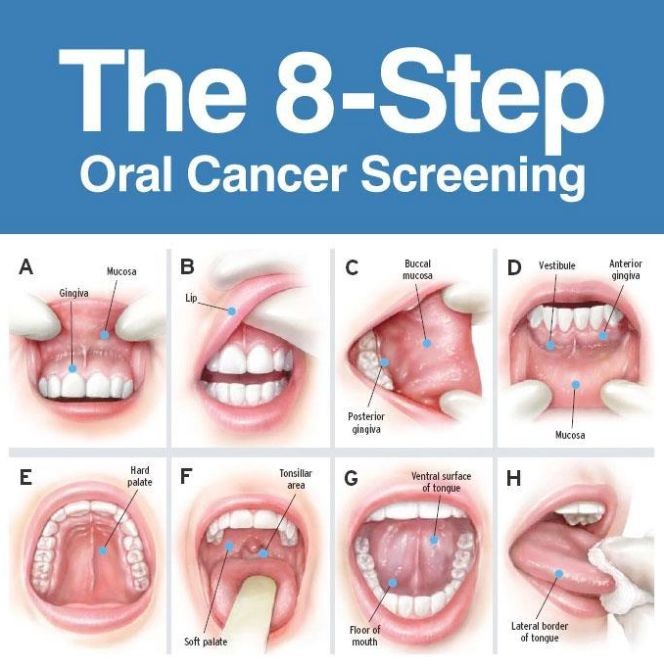
Contents
How Do You Detect Oral Cancer?
Performing self-examinations of your mouth, tongue, and cheeks is one of the most effective ways to routinely detect oral cancer.
To routinely detect mouth cancer at home, examine your:
Oral cancer, also known as mouth cancer, is a type of cancer that develops in the tissues of the mouth or throat and is part of a larger group of head and neck cancer. It primarily develops in the lips, mouth, and tongue.
Oral cancer is frequently discovered after it has spread to the neck’s lymph nodes.
6 early signs and symptoms of oral cancer
Recognize the 6 early warning signs of oral cancer:
- Unhealed sores in and around your mouth
- Numb whitish patch over your tongue or oral cavity
- Difficulty eating or swallowing, jaw swelling, or a lump in your throat
- Mouth pain
- Numbness of the tongue
- Lump in the neck
During your routine examination, you may need to:
- Look for red, white, or dark patches in and around the tongue.
- Feel for any protrusions or raised areas.
- Lift your tongue to the roof of your mouth and then move it left and right to look beneath for signs of discomfort.
- Manually examine your cheeks by gently squeezing them between your thumb and index finger; this is one of the best ways to detect lumps, bumps, or slight swelling.
- Inspect your neck area by running your fingers gently along the side, feeling for any lumps or bumps that are out of the ordinary. Take note of any minor tenderness or swelling.
Because oral cancer is usually painless, don’t expect sharp pain.
The first sign of oral cancer is usually a small sore, which falls under three types:
- Leukoplakia (white sores)
- Erythroplakia (red sores)
- Erythroleukoplakia (combination white and red sores) on the lips, gums, tongue, or mouth lining
Over time, these progress to:
- Lump or thickening of the lips or gums
- Bleeding
- Pain
- Numbness in the lips or mouth
- Change in voice
- Loose teeth
- Difficulty chewing, swallowing, or speaking
- Swelling of the jaw
- Sore throat
Consult your dentist or doctor as soon as you notice any of the symptoms listed above.
How is oral cancer diagnosed?
Dentists and doctors use the following methods to diagnose oral cancer:
Oral cancer screening
A cancer workup begins with a personal medical history and a complete head and neck exam. The doctor looks for and feels any abnormalities inside your mouth with gloved fingers.
Lesions in the mouth are coated with a blue dye and examined for areas that stain darker, indicating they are more likely to become cancerous.
Lesions in the mouth are examined with a special light after administering a fluorescent mouth rinse, revealing abnormal tissue.
Cells from a suspicious area are gently scraped from the lips, tongue, or mouth with a piece of cotton or wooden stick and examined under a microscope for abnormalities.
Biopsy
A cancer diagnosis is determined by taking a sample of tissue or cells and inspecting it under a microscope.
Imaging tests may be used to learn more about the tumor, its location, and any regional spread to the lymph nodes or jawbone, such as:
- Dental X-rays
- Computed tomography or computed axial tomography scans
- Magnetic resonance imaging scans
- Positron emission tomography scans
Oral cancer remains a significant public health concern regardless of age, race, or socioeconomic status.
Early detection of oral cancer is critical to improving survival rates. This requires thorough clinical examinations of the face, mouth, and neck at regular intervals, as well as an understanding of the common signs and symptoms of cancer.
Dental hygienists have a unique role in early cancer detection as they routinely perform such examinations and educate people on self-examination and risk factor management.
What are risk factors for mouth cancer?
Men have a higher lifetime risk of oral cancer than women, especially men over 50 years old.
The most common risk factors for mouth cancer include:
- Smoking, which increases the risk sixfold
- Alcohol use, which increases the risk sixfold
- Tobacco, snuff, or dip use, which increases the risk 50-fold
- Excessive sun exposure
- Human papillomavirus strains associated with an increased risk
- Occupational exposures, poor oral hygiene, malnutrition, radiation exposure, Epstein-Barr virus infection, and a family history of cancer
Oral cancer is common but treatable when detected early. A doctor or dentist can usually detect oral cancer during a routine mouth exam.
Avoiding smoking and tobacco can significantly reduce your risk as the majority of people who develop oral cancer are smokers or tobacco users.
What are the treatment options for mouth cancer?
Treatment of mouth cancer is critical in the early stages for better survival chances.
Oral cancer is classified into four stages:
- Tumor has not spread to the lymph nodes and is less than or equal to two centimeters in size
- Tumor grows between two and four centimeters and has spread to the lymph nodes
- Tumor spreads to one lymph node and grows larger than four centimeters
- Tumor grows and spreads to the lymph nodes and other surrounding organs
Oral cancer treatment depends on the location, stage, and type of cancer, but may include:
- Surgery to remove the tumor and prevent its spread
- Chemotherapy to kill cancer cells
- Radiation therapy to focus radiation beams on the tumor
Radiation therapy and chemotherapy are used at advanced stages of cancer.
- Targeted therapy to obstruct the growth of cancer cells
Without treatment, mouth cancer has a very low survival rate. Factors such as cancer stage, location, and age affect the survival rate.
For early-stage mouth cancer, the five-year survival rate is about 30 percent, whereas for stage IV mouth cancer, the rate drops to 12 percent.
For early-stage mouth cancer, the five-year survival rate is about 30 percent, whereas for stage IV mouth cancer, the rate drops to 12 percent.


